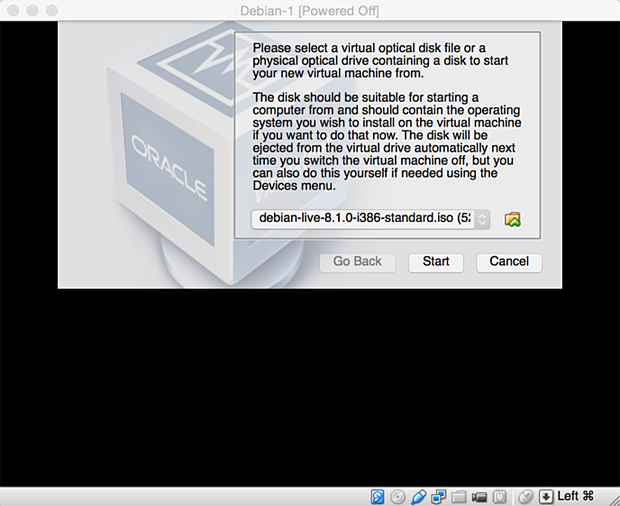Install Debian On Vm

Debian 7 documentation covers information on how to install the operating system in a virtual machine. For additional information about the operating system, refer to the instructions included in the installation media. Debian 7 documentation includes the following topics: • • • • Installation Instructions The easiest method of installing Debian 7 in a virtual machine is to use the standard Debian 7 distribution CD. Prerequisites Before you begin, verify that the following tasks are complete: • Read. • With many Linux guest operating systems, various problems have been observed when the BusLogic virtual SCSI adapter is used with VMware virtual machines.

VMware recommends that you use the Vmware Paravirtual SCSI adapter or LSI Logic virtual SCSI adapter with this guest operating system. Installation Steps • Insert the Debian 7 installation media in the CD-ROM drive. • Power on the virtual machine. • From the Boot options, select Install for text mode installation or Graphical Install for graphic user interface installation. • During the installation you might be prompted to Configure the package manager using Scan another CD or DVD or Use a network mirror. • If you have additional installation media to install software select Yes and follow the prompts.
• If you select Use a network mirror to install software, you are prompted for HTTP Proxy information. • (Optional) If you have the HTTP proxy information, type it in the space provided, otherwise leave it blank. • Follow the prompts to complete the installation. • Install either Open VM Tools or VMware Tools. The New Cactus Lexicon Free.
Download VirtualBox for Linux Hosts VirtualBox 5.2.2 for Linux. Note: The package architecture has to match the Linux kernel architecture, that is, if you are running. Download Apache Hadoop Sandbox, Hortonworks Data Platform (HDP) and DataFlow (HDF) and get access to release notes, installation guides, tutorials and more. May 31, 2013. In this post I show how to create a stripped-down Debian Linux virtual machine inside VirtualBox. It does not have a GUI desktop installed, so you have to interact with it through commands entered in a shell (you can add your own GUI later, if you'd like). The screenshots come from a Mac, but the install. How to download and install prebuilt OpenJDK packages JDK 8 Debian, Ubuntu, etc. On the command line, type: $ sudo apt-get install openjdk-8-jre. The openjdk-8-jre.
VMware recommends using the Open VM Tools included with Debian 7. VMware Tools in a Debian 7 Guest Use the guest OS provided Open VM Tools or install the VMware Tools, as needed. Open VM Tools Open VM Tools is the open source implementation of VMware Tools and consist of a suite of virtualization utilities that improves the functionality, administration, and management of virtual machines on VMware hypervisors. VMware recommends using the Open VM Tools redistributed by the operating system vendors. For additional information, see knowledge base article 2073803, VMware support of open-vm-tools,.
Install Open VM Tools • Add the following line to the /etc/apt/sources.list file. Deb wheezy main contrib • Run the commands: $ sudo apt-get update $ sudo apt-get install open-vm-tools Add the vmhgfs Driver If you use the file sharing feature by using Shared Folders in VMware Workstation and Fusion, install the vmhgfs driver in the virtual machine. This driver is not included inbox in the operating system. Installing the additional vmhgfs driver does not disturb the other inbox VMware drivers or Open VMware Tools. To install this driver: • Install Open VMware Tools. • Install the traditional TAR Format VMware Tools that is bundled with VMware Workstation or Fusion products VMware Tools For information on VMware Tools, see Knowledge base article 1014294, General VMware Tools installation instructions,. Knowledge Base Articles for Debian 7 The following link refers to knowledge base articles on operating system specific issues.
See for a list of known issues about the operating system. VMware Compatibility Guide The Web site lists supported guest and host operating systems and provides related support information.
What you basically want to do is change the resolution of the. Here's the process I used (supposing that your desired resolution is 1024x768, and that Hyper-V's framebuffer supports this resolution): • Open up /etc/default/grub with superuser privileges: sudo nano /etc/default/grub • Uncomment/add the following lines: GRUB_GFXMODE=1024x768x32 GRUB_GFXPAYLOAD_LINUX=keep • Save the file and exit: Ctrl- O, Enter, Ctrl- X • Run update-grub as superuser: sudo update-grub • Reboot, and (hopefully) enjoy a higher-resolution console!